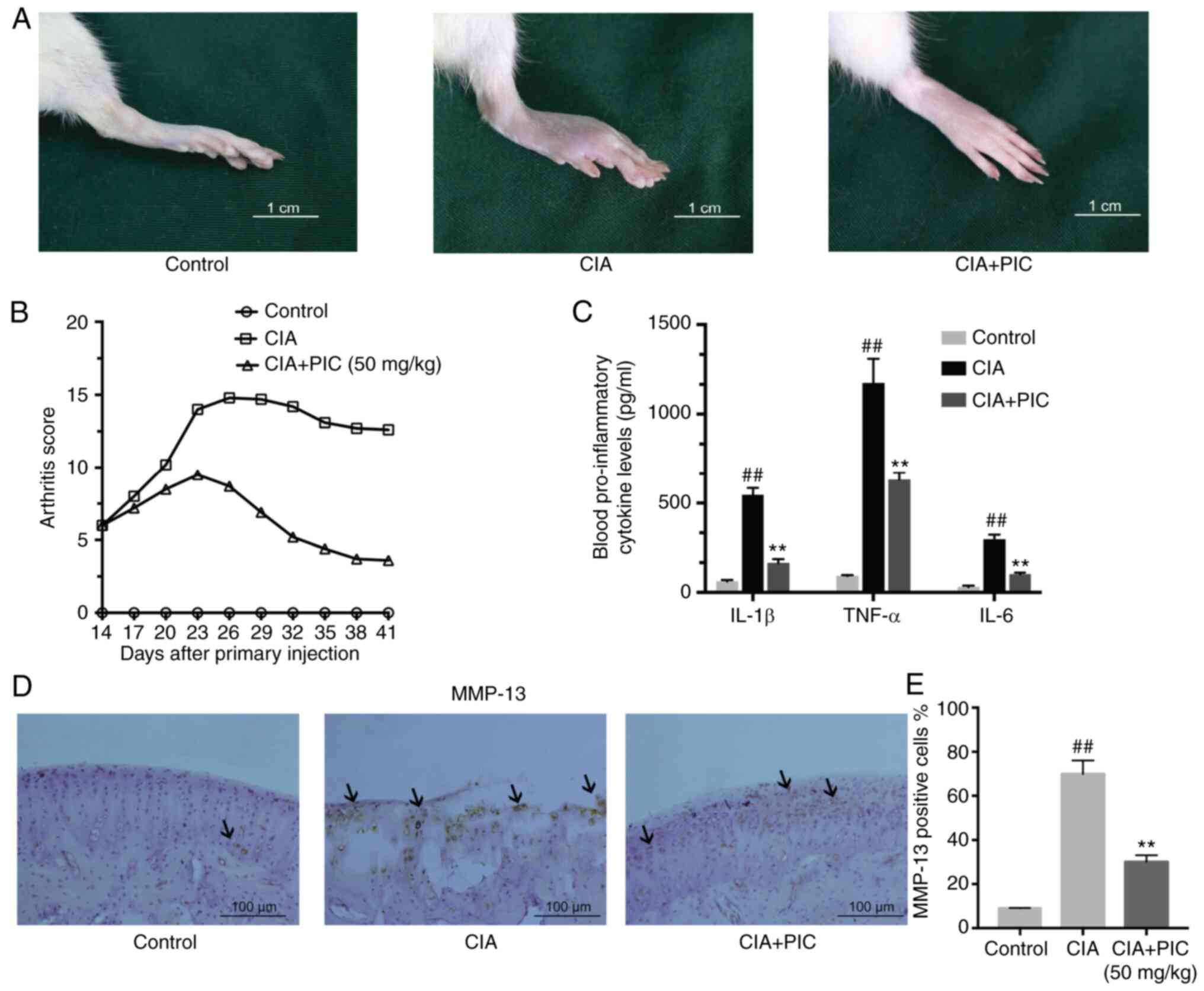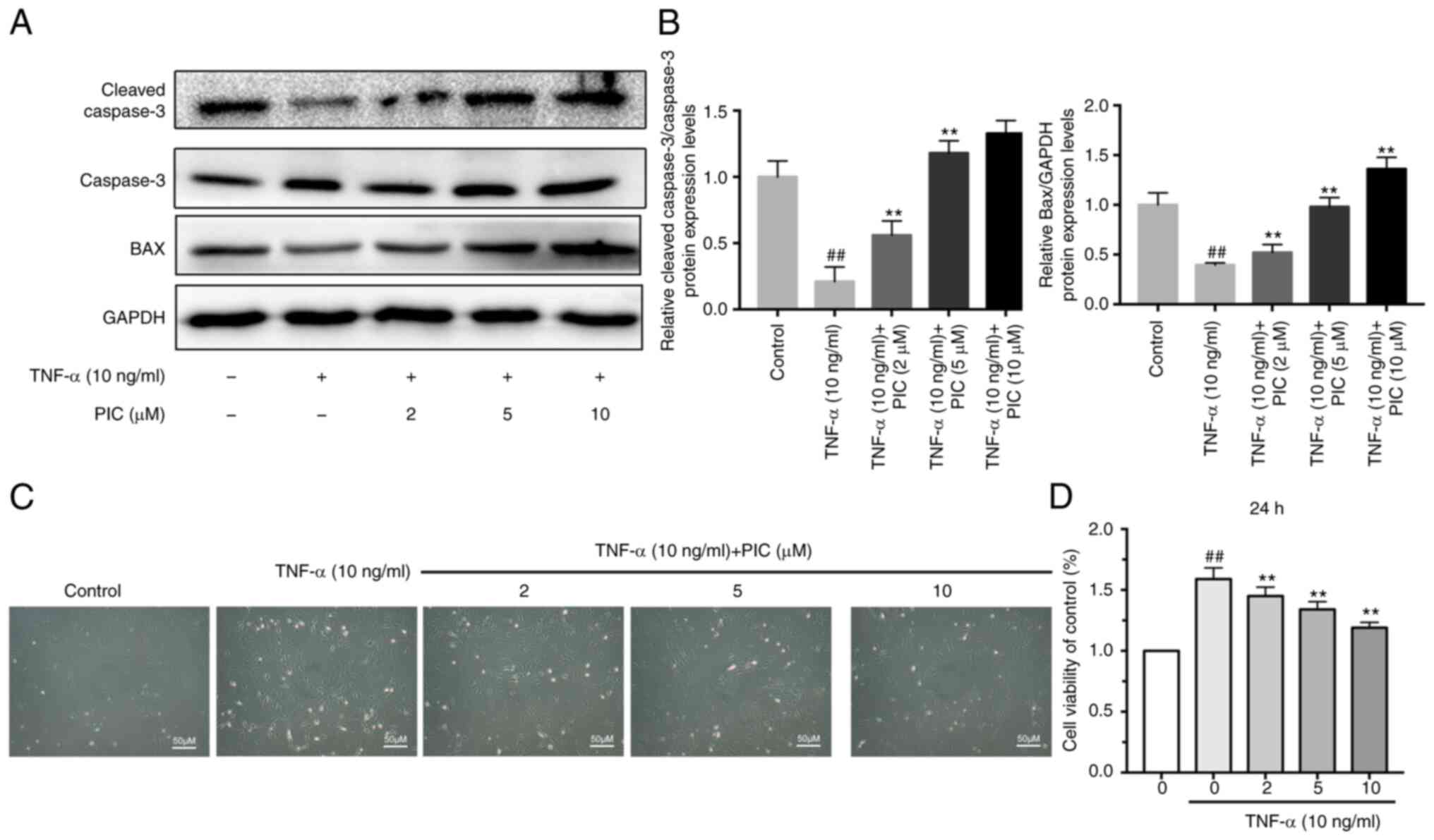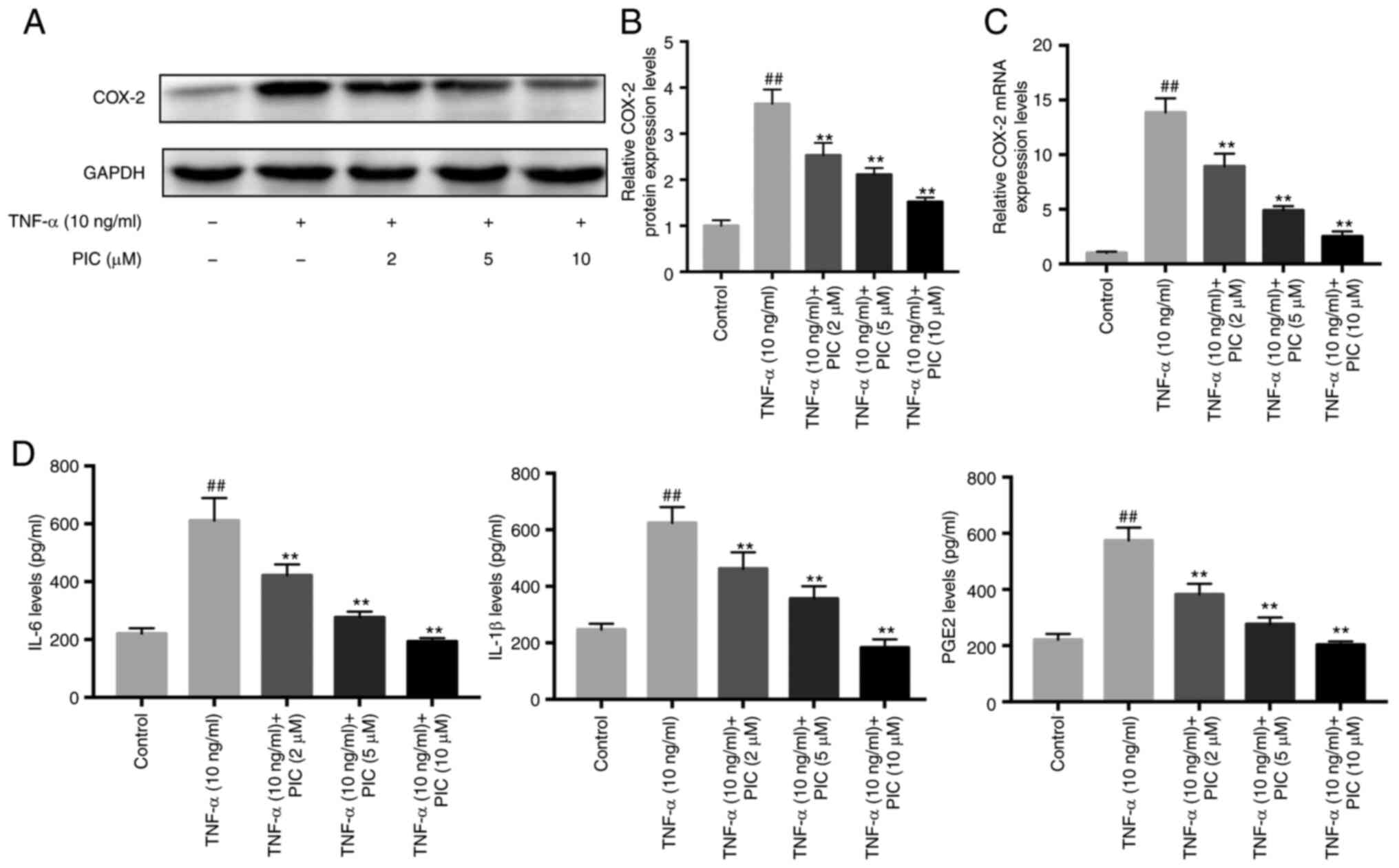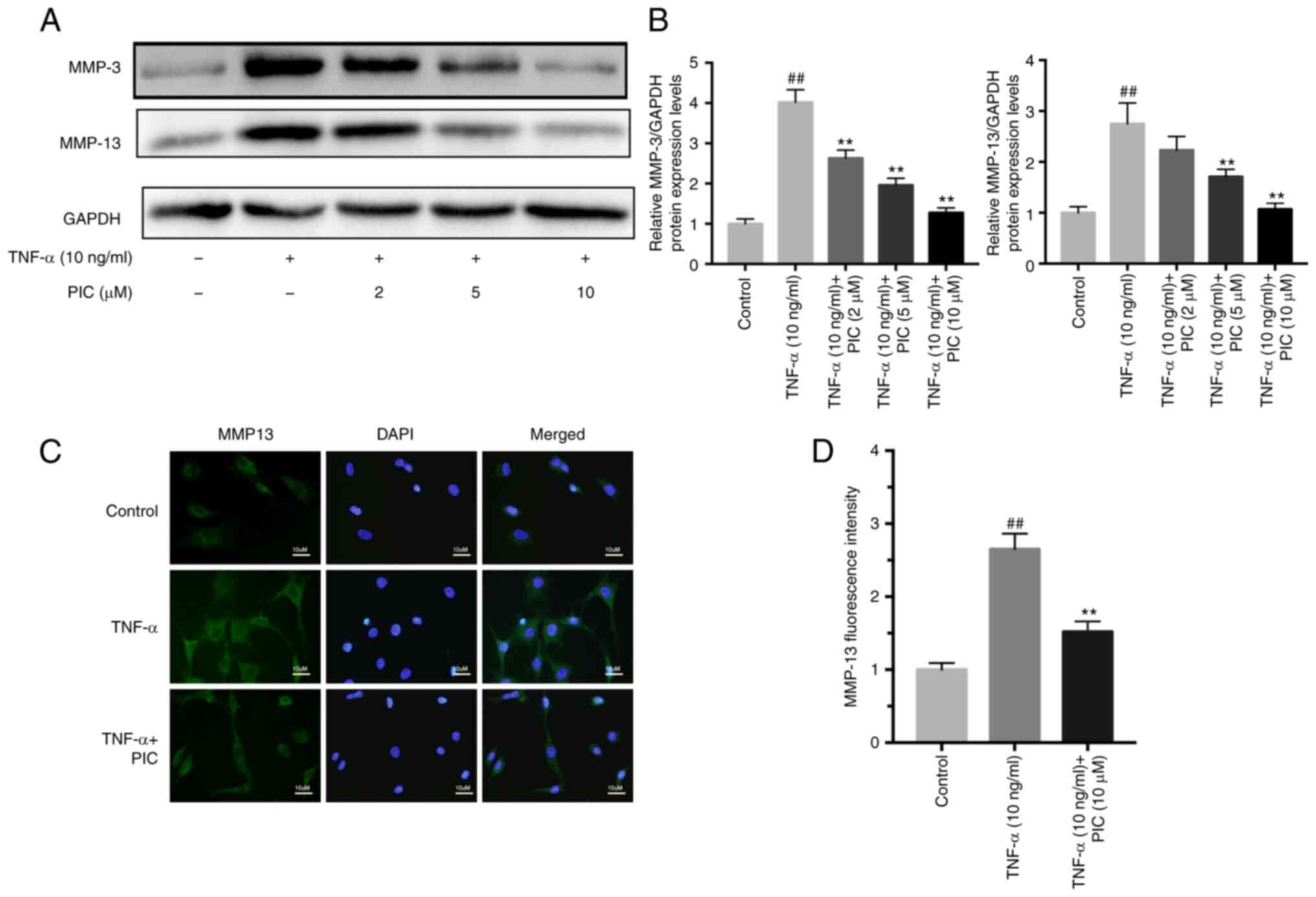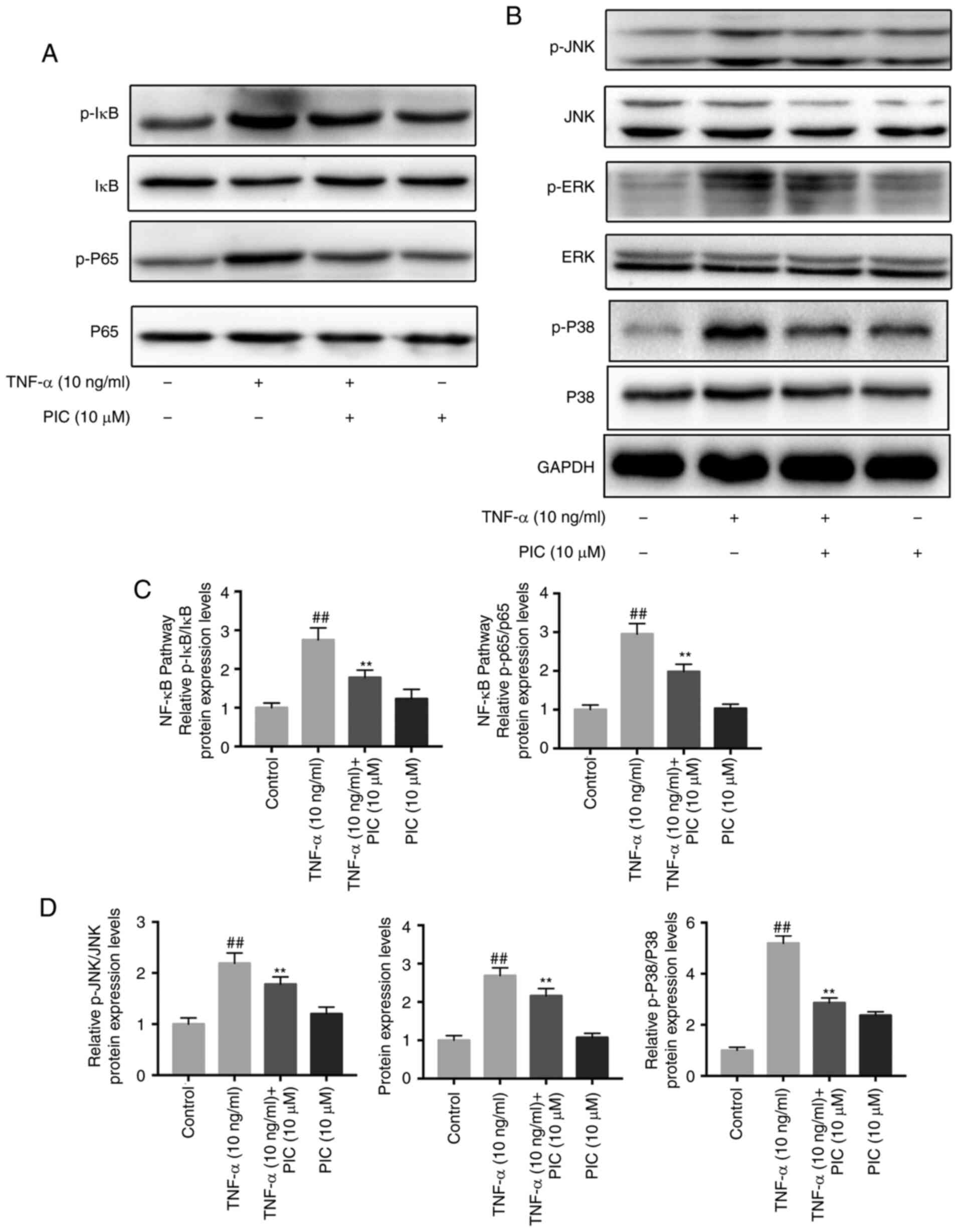|
1
|
McInnes IB and Schett G: The pathogenesis
of rheumatoid arthritis. N Engl J Med. 365:2205–2219. 2011.
View Article : Google Scholar : PubMed/NCBI
|
|
2
|
Firestein GS and McInnes IB:
Immunopathogenesis of rheumatoid arthritis. Immunity. 46:183–196.
2017. View Article : Google Scholar : PubMed/NCBI
|
|
3
|
Bartok B and Firestein GS: Fibroblast-like
synoviocytes: Key effector cells in rheumatoid arthritis. Immunol
Rev. 233:233–255. 2010. View Article : Google Scholar : PubMed/NCBI
|
|
4
|
Bindu S, Mazumder S and Bandyopadhyay U:
Non-steroidal anti-inflammatory drugs (NSAIDs) and organ damage: A
current perspective. Biochem Pharmacol. 180:1141472020. View Article : Google Scholar : PubMed/NCBI
|
|
5
|
Friedman B and Cronstein B: Methotrexate
mechanism in treatment of rheumatoid arthritis. Joint Bone Spine.
86:301–307. 2019. View Article : Google Scholar : PubMed/NCBI
|
|
6
|
McInnes IB and Schett G: Cytokines in the
pathogenesis of rheumatoid arthritis. Nat Rev Immunol. 7:429–442.
2007. View
Article : Google Scholar : PubMed/NCBI
|
|
7
|
Moreland LW, Schiff MH, Baumgartner SW,
Tindall EA, Fleischmann RM, Bulpitt KJ, Weaver AL, Keystone EC,
Furst DE, Mease PJ, et al: Etanercept therapy in rheumatoid
arthritis: A randomized, controlled trial. Ann Intern Med.
130:478–486. 1999. View Article : Google Scholar : PubMed/NCBI
|
|
8
|
Bongartz T, Sutton AJ, Sweeting MJ, Buchan
I, Matteson EL and Montori V: Anti-TNF antibody therapy in
rheumatoid arthritis and the risk of serious infections and
malignancies: Systematic review and meta-analysis of rare harmful
effects in randomized controlled trials. JAMA. 295:2275–2285. 2006.
View Article : Google Scholar : PubMed/NCBI
|
|
9
|
Brennan FM, Maini RN and Feldmann M:
TNFα-a pivotal role in rheumatoid arthritis? Rheumatology.
31:293–298. 1992. View Article : Google Scholar : PubMed/NCBI
|
|
10
|
Marrelli A, Cipriani P, Liakouli V,
Carubbi F, Perricone C, Perricone R and Giacomelli R: Angiogenesis
in rheumatoid arthritis: A disease specific process or a common
response to chronic inflammation? Autoimmun Rev. 10:595–598. 2011.
View Article : Google Scholar : PubMed/NCBI
|
|
11
|
Pap T and Korb-Pap A: Cartilage damage in
osteoarthritis and rheumatoid arthritis-two unequal siblings. Nat
Rev Rheumatol. 11:606–615. 2015. View Article : Google Scholar : PubMed/NCBI
|
|
12
|
Mor A, Abramson SB and Pillinger MH: The
fibroblast-like synovial cell in rheumatoid arthritis: A key player
in inflammation and joint destruction. Clin Immunol. 115:118–128.
2005. View Article : Google Scholar : PubMed/NCBI
|
|
13
|
Szekeres T, Fritzer-Szekeres M, Saiko P
and Jäger W: Resveratrol and resveratrol
analogues-structure-activity relationship. Pharm Res. 27:1042–1048.
2010. View Article : Google Scholar : PubMed/NCBI
|
|
14
|
Kim YH, Kwon HS, Kim DH, Cho HJ, Lee HS,
Jun JG, Park JH and Kim JK: Piceatannol, a stilbene present in
grapes, attenuates dextran sulfate sodium-induced colitis. Int
Immunopharmacol. 8:1695–1702. 2008. View Article : Google Scholar : PubMed/NCBI
|
|
15
|
Kita Y, Miura Y and Yagasaki K:
Antiproliferative and anti-invasive effect of piceatannol, a
polyphenol present in grapes and wine, against hepatoma AH109A
cells. J Biomed Biotechnol. 2012:6724162012. View Article : Google Scholar : PubMed/NCBI
|
|
16
|
Kwon JY, Seo SG, Heo YS, Yue S, Cheng JX,
Lee KW and Kim KH: Piceatannol, natural polyphenolic stilbene,
inhibits adipogenesis via modulation of mitotic clonal expansion
and insulin receptor-dependent insulin signaling in early phase of
differentiation. J Biol Chem. 287:11566–11578. 2012. View Article : Google Scholar : PubMed/NCBI
|
|
17
|
Ashikawa K, Majumdar S, Banerjee S, Bharti
AC, Shishodia S and Aggarwal BB: Piceatannol inhibits TNF-induced
NF-kappaB activation and NF-kappaB-mediated gene expression through
suppression of IkappaBalpha kinase and p65 phosphorylation. J
Immunol. 169:6490–6497. 2002. View Article : Google Scholar : PubMed/NCBI
|
|
18
|
Djoko B, Chiou R YY, Shee JJ and Liu YW:
Characterization of immunological activities of peanut stilbenoids,
arachidin-1, piceatannol, and resveratrol on
lipopolysaccharide-induced inflammation of RAW 264.7 macrophages. J
Agric Food Chem. 55:2376–2383. 2007. View Article : Google Scholar : PubMed/NCBI
|
|
19
|
Son Y, Chung HT and Pae HO: Differential
effects of resveratrol and its natural analogs, piceatannol and
3,5,4′-trans-trimethoxystilbene, on anti-inflammatory heme
oxigenase-1 expression in RAW264.7 macrophages. Biofactors.
40:138–145. 2014. View Article : Google Scholar : PubMed/NCBI
|
|
20
|
Jin CY, Moon DO, Lee KJ, Kim MO, Lee JD,
Choi YH, Park YM and Kim GY: Piceatannol attenuates
lipopolysaccharide-induced NF-kappaB activation and
NF-kappaB-related proinflammatory mediators in BV2 microglia.
Pharmacol Res. 54:461–467. 2006. View Article : Google Scholar : PubMed/NCBI
|
|
21
|
Trentham DE, Townes AS and Kang AH:
Autoimmunity to type II collagen an experimental model of
arthritis. J Exp Med. 146:857–868. 1977. View Article : Google Scholar : PubMed/NCBI
|
|
22
|
National Institutes of Health, . Guide for
the Care and Use of Laboratory Animals. National Academies;
1985
|
|
23
|
Zhu L and Zhu L: Sophocarpine suppress
inflammatory response in human fibroblast-like synoviocytes and in
mice with collagen-induced arthritis. Eur Cytokine Netw.
28:120–126. 2017. View Article : Google Scholar : PubMed/NCBI
|
|
24
|
Brand DD, Latham KA and Rosloniec EF:
Collagen-induced arthritis. Nat Protoc. 2:1269–1275. 2007.
View Article : Google Scholar : PubMed/NCBI
|
|
25
|
Pfaffl MW: A new mathematical model for
relative quantification in real-time RT-PCR. Nucleic Acids Res.
29:e452001. View Article : Google Scholar : PubMed/NCBI
|
|
26
|
Kim M, Sur B, Villa T, Yun J, Nah SY and
Oh S: Gintonin regulates inflammation in human IL-1β-stimulated
fibroblast-like synoviocytes and carrageenan/kaolin-induced
arthritis in rats through LPAR2. J Ginseng Res. 45:575–582. 2021.
View Article : Google Scholar : PubMed/NCBI
|
|
27
|
Li N, Xu Q, Liu Q, Pan D, Jiang Y, Liu M,
Liu M, Xu H and Lin C: Leonurine attenuates fibroblast-like
synoviocyte-mediated synovial inflammation and joint destruction in
rheumatoid arthritis. Rheumatology. 56:1417–1427. 2017. View Article : Google Scholar : PubMed/NCBI
|
|
28
|
Ovesná Z, Kozics K, Bader Y, Saiko P,
Handler N, Erker T and Szekeres T: Antioxidant activity of
resveratrol, piceatannol and
3,3′,4,4′,5,5′-hexahydroxy-trans-stilbene in three leukemia cell
lines. Oncol Rep. 16:617–624. 2006.PubMed/NCBI
|
|
29
|
Wang B and Li J: Piceatannol suppresses
the proliferation and induced apoptosis of osteosarcoma cells
through PI3K/AKT/mTOR pathway. Cancer Manag Res. 12:2631–2640.
2020. View Article : Google Scholar : PubMed/NCBI
|
|
30
|
Hao L, Wan Y, Xiao J, Tang Q, Deng H and
Chen L: A study of Sirt1 regulation and the effect of resveratrol
on synoviocyte invasion and associated joint destruction in
rheumatoid arthritis. Mol Med Rep. 16:5099–5106. 2017. View Article : Google Scholar : PubMed/NCBI
|
|
31
|
Chen WP, Hung LM, Hsueh CH, Lai LP and Su
MJ: Piceatannol, a derivative of resveratrol, moderately slows
I(Na) inactivation and exerts antiarrhythmic action in
ischaemia-reperfused rat hearts. Br J Pharmacol. 157:381–391. 2010.
View Article : Google Scholar
|
|
32
|
Smith MD, Weedon H, Papangelis V, Walker
J, Roberts-Thomson PJ and Ahern MJ: Apoptosis in the rheumatoid
arthritis synovial membrane: Modulation by disease-modifying
anti-rheumatic drug treatment. Rheumatology (Oxford). 49:862–875.
2010. View Article : Google Scholar : PubMed/NCBI
|
|
33
|
Cai L, Zong P, Zhou MY, Liu FY, Meng B,
Liu MM, Li Z and Li R: 7-Hydroxycoumarin mitigates the severity of
collagen-induced arthritis in rats by inhibiting proliferation and
inducing apoptosis of fibroblast-like synoviocytes via suppression
of Wnt/β-catenin signaling pathway. Phytomedicine. 94:1538412022.
View Article : Google Scholar : PubMed/NCBI
|
|
34
|
Namba S, Nakano R, Kitanaka T, Kitanaka N,
Nakayama T and Sugiya H: ERK2 and JNK1 contribute to TNF-α-induced
IL-8 expression in synovial fibroblasts. PLoS One. 12:e01829232017.
View Article : Google Scholar : PubMed/NCBI
|
|
35
|
Yoon CH, Chung SJ, Lee SW, Park YB, Lee SK
and Park MC: Gallic acid, a natural polyphenolic acid, induces
apoptosis and inhibits proinflammatory gene expressions in
rheumatoid arthritis fibroblast-like synoviocytes. Joint Bone
Spine. 80:274–279. 2013. View Article : Google Scholar : PubMed/NCBI
|
|
36
|
Harizi H, Corcuff JB and Gualde N:
Arachidonic-acid-derived eicosanoids: Roles in biology and
immunopathology. Trends Mol Med. 14:461–469. 2008. View Article : Google Scholar : PubMed/NCBI
|
|
37
|
Itoh Y: Metalloproteinases: Potential
therapeutic targets for rheumatoid arthritis. Endocr Metab Immune
Disord Drug Targets. 15:216–222. 2015. View Article : Google Scholar : PubMed/NCBI
|
|
38
|
Yoshihara Y, Nakamura H, Obata K, Yamada
H, Hayakawa T, Fujikawa K and Okada Y: Matrix metalloproteinases
and tissue inhibitors of metalloproteinases in synovial fluids from
patients with rheumatoid arthritis or osteoarthritis. Ann Rheum
Dis. 59:455–461. 2000. View Article : Google Scholar : PubMed/NCBI
|
|
39
|
Brennan FM, Browne KA, Green PA, Jaspar
JM, Maini RN and Feldmann M: Reduction of serum matrix
metalloproteinase 1 and matrix metalloproteinase 3 in rheumatoid
arthritis patients following anti-tumour necrosis factor-alpha
(cA2) therapy. Br J Rheumatol. 36:643–650. 1997. View Article : Google Scholar : PubMed/NCBI
|
|
40
|
Zhai KF, Duan H, Luo L, Cao WG, Han FK,
Shan LL and Fang XM: Protective effects of paeonol on inflammatory
response in IL-1β-induced human fibroblast-like synoviocytes and
rheumatoid arthritis progression via modulating NF-κB pathway.
Inflammopharmacology. 25:523–532. 2017. View Article : Google Scholar
|
|
41
|
Brown KD, Claudio E and Siebenlist U: The
roles of the classical and alternative nuclear factor-kappaB
pathways: Potential implications for autoimmunity and rheumatoid
arthritis. Arthritis Res Ther. 10:2122008. View Article : Google Scholar : PubMed/NCBI
|
|
42
|
Ke J, Long X, Liu Y, Zhang YF, Li J, Fang
W and Meng QG: Role of NF-kappaB in TNF-alpha-induced COX-2
expression in synovial fibroblasts from human TMJ. J Dent Res.
86:363–367. 2007. View Article : Google Scholar : PubMed/NCBI
|
|
43
|
Culbert AA, Skaper SD, Howlett DR, Evans
NA, Facci L, Soden PE, Seymour ZM, Guillot F, Gaestel M and
Richardson JC: MAPK-activated protein kinase 2 deficiency in
microglia inhibits pro-inflammatory mediator release and resultant
neurotoxicity. Relevance to neuroinflammation in a transgenic mouse
model of Alzheimer disease. J Biol Chem. 281:23658–23667. 2006.
View Article : Google Scholar : PubMed/NCBI
|
|
44
|
Schett G, Tohidast-Akrad M, Smolen JS,
Schmid BJ, Steiner CW, Bitzan P, Zenz P, Redlich K, Xu Q and
Steiner G: Activation, differential localization, and regulation of
the stress-activated protein kinases, extracellular
signal-regulated kinase, c-JUN N-terminal, and p38
mitogen-activated protein kinase, in synovial tissue and cells in
rheumatoid arthritis. Arthritis Rheum. 43:2501–2512. 2000.
View Article : Google Scholar : PubMed/NCBI
|
|
45
|
Han Z, Boyle DL, Chang L, Bennett B, Karin
M, Yang L, Manning AM and Firestein GS: c-Jun N-terminal kinase is
required for metalloproteinase expression and joint destruction in
inflammatory arthritis. J Clin Invest. 108:73–81. 2001. View Article : Google Scholar : PubMed/NCBI
|
|
46
|
Joe B and Wilder RL: Animal models of
rheumatoid arthritis. Mol Med Today. 5:367–369. 1999. View Article : Google Scholar : PubMed/NCBI
|
|
47
|
Marinova-Mutafchieva L, Williams RO, Mason
LJ, Mauri C, Feldmann M and Maini RN: Dynamics of proinflammatory
cytokine expression in the joints of mice with collagen-induced
arthritis (CIA). Clin Exp Immunol. 107:507–512. 1997. View Article : Google Scholar : PubMed/NCBI
|















